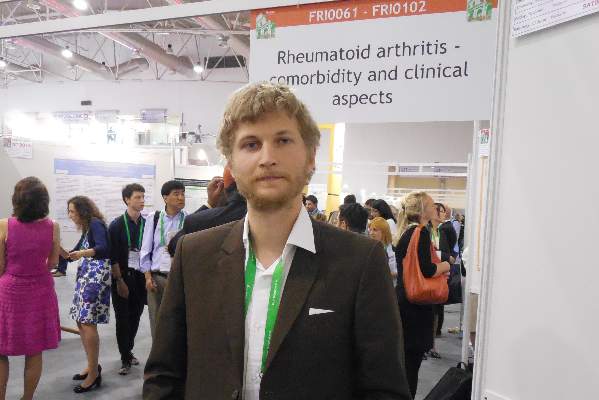User login
ROME – Women with rheumatoid arthritis who have never been treated with a biologic drug had a modest but statistically significant increased rate of cervical intraepithelial neoplasia in a case-control study with more than 335,000 women.
The analysis showed an adjusted excess hazard for developing cervical intraepithelial neoplasia (CIN) I of 53%, compared with the general population, and an excess 39% rate of CIN II or III, both statistically significant differences, Dr. Hjalmar Wadstrom reported in a poster at the European Congress of Rheumatology.
The analysis also showed a small increase in the relative rate of invasive cervical cancers among the women with rheumatoid arthritis (RA) on treatment with conventional disease-modifying drugs, such as methotrexate, who never received a biologic disease-modifying drug. The 9% relative increase in the rate of invasive cancer, compared with the general population, did not achieve statistical significance, reported Dr. Wadstrom, a clinical epidemiology researcher at the Karolinska Institute in Stockholm.
The “moderately but not dramatically” increased rate of CIN “is not a reason for big concern or alarm,” but highlights that women with RA should comply with local cervical cancer–screening recommendations and programs, said Dr. Johan Askling, professor of rheumatology and clinical epidemiology at Karolinska and senior author of the study.
“It would be a shame if these RA patients with a small increased risk did not attend the [cervical screening] programs we have set up. Clinicians should make sure that women with RA attend to screening because nonattendance is their major risk factor,” he said in an interview. “Our findings don’t call for a change in screening recommendations, they just highlight the importance of attending to screening” in women with RA, Dr. Askling said.
The researchers ran a linkage analysis of Swedish registries and identified 34,984 adult women with RA and matched them with 300,331 women drawn from the general Swedish population. Age of the RA patients ranged from 18 to 97 years with a median age of 62 years, and they selected general-population controls who matched this group. In the regression analyses they ran to calculate hazard ratios they adjusted for age, education, prior cervical screening, comorbidities, marital status, and time hospitalized during prior 5 years. The analysis included CIN and invasive cancer cases during 14 years of follow-up, 1999-2012.
Both Dr. Wadstrom and Dr. Askling cited two potential factors behind the increased rates of CIN I, II, and III in women with RA: the inflammatory state of RA and treatment with immunosuppressive nonbiologic agents, such as methotrexate.
The increased CIN rates found in this analysis were also “seen in other patients treated with potent immunosuppressive drugs,” like organ transplant patients, Dr. Askling noted.
The current study serves as prelude to an analysis he and his associates are now running to assess cervical neoplasia and cancer rates among women with RA treated with biologic disease-modifying drugs.
On Twitter @mitchelzoler
ROME – Women with rheumatoid arthritis who have never been treated with a biologic drug had a modest but statistically significant increased rate of cervical intraepithelial neoplasia in a case-control study with more than 335,000 women.
The analysis showed an adjusted excess hazard for developing cervical intraepithelial neoplasia (CIN) I of 53%, compared with the general population, and an excess 39% rate of CIN II or III, both statistically significant differences, Dr. Hjalmar Wadstrom reported in a poster at the European Congress of Rheumatology.
The analysis also showed a small increase in the relative rate of invasive cervical cancers among the women with rheumatoid arthritis (RA) on treatment with conventional disease-modifying drugs, such as methotrexate, who never received a biologic disease-modifying drug. The 9% relative increase in the rate of invasive cancer, compared with the general population, did not achieve statistical significance, reported Dr. Wadstrom, a clinical epidemiology researcher at the Karolinska Institute in Stockholm.
The “moderately but not dramatically” increased rate of CIN “is not a reason for big concern or alarm,” but highlights that women with RA should comply with local cervical cancer–screening recommendations and programs, said Dr. Johan Askling, professor of rheumatology and clinical epidemiology at Karolinska and senior author of the study.
“It would be a shame if these RA patients with a small increased risk did not attend the [cervical screening] programs we have set up. Clinicians should make sure that women with RA attend to screening because nonattendance is their major risk factor,” he said in an interview. “Our findings don’t call for a change in screening recommendations, they just highlight the importance of attending to screening” in women with RA, Dr. Askling said.
The researchers ran a linkage analysis of Swedish registries and identified 34,984 adult women with RA and matched them with 300,331 women drawn from the general Swedish population. Age of the RA patients ranged from 18 to 97 years with a median age of 62 years, and they selected general-population controls who matched this group. In the regression analyses they ran to calculate hazard ratios they adjusted for age, education, prior cervical screening, comorbidities, marital status, and time hospitalized during prior 5 years. The analysis included CIN and invasive cancer cases during 14 years of follow-up, 1999-2012.
Both Dr. Wadstrom and Dr. Askling cited two potential factors behind the increased rates of CIN I, II, and III in women with RA: the inflammatory state of RA and treatment with immunosuppressive nonbiologic agents, such as methotrexate.
The increased CIN rates found in this analysis were also “seen in other patients treated with potent immunosuppressive drugs,” like organ transplant patients, Dr. Askling noted.
The current study serves as prelude to an analysis he and his associates are now running to assess cervical neoplasia and cancer rates among women with RA treated with biologic disease-modifying drugs.
On Twitter @mitchelzoler
ROME – Women with rheumatoid arthritis who have never been treated with a biologic drug had a modest but statistically significant increased rate of cervical intraepithelial neoplasia in a case-control study with more than 335,000 women.
The analysis showed an adjusted excess hazard for developing cervical intraepithelial neoplasia (CIN) I of 53%, compared with the general population, and an excess 39% rate of CIN II or III, both statistically significant differences, Dr. Hjalmar Wadstrom reported in a poster at the European Congress of Rheumatology.
The analysis also showed a small increase in the relative rate of invasive cervical cancers among the women with rheumatoid arthritis (RA) on treatment with conventional disease-modifying drugs, such as methotrexate, who never received a biologic disease-modifying drug. The 9% relative increase in the rate of invasive cancer, compared with the general population, did not achieve statistical significance, reported Dr. Wadstrom, a clinical epidemiology researcher at the Karolinska Institute in Stockholm.
The “moderately but not dramatically” increased rate of CIN “is not a reason for big concern or alarm,” but highlights that women with RA should comply with local cervical cancer–screening recommendations and programs, said Dr. Johan Askling, professor of rheumatology and clinical epidemiology at Karolinska and senior author of the study.
“It would be a shame if these RA patients with a small increased risk did not attend the [cervical screening] programs we have set up. Clinicians should make sure that women with RA attend to screening because nonattendance is their major risk factor,” he said in an interview. “Our findings don’t call for a change in screening recommendations, they just highlight the importance of attending to screening” in women with RA, Dr. Askling said.
The researchers ran a linkage analysis of Swedish registries and identified 34,984 adult women with RA and matched them with 300,331 women drawn from the general Swedish population. Age of the RA patients ranged from 18 to 97 years with a median age of 62 years, and they selected general-population controls who matched this group. In the regression analyses they ran to calculate hazard ratios they adjusted for age, education, prior cervical screening, comorbidities, marital status, and time hospitalized during prior 5 years. The analysis included CIN and invasive cancer cases during 14 years of follow-up, 1999-2012.
Both Dr. Wadstrom and Dr. Askling cited two potential factors behind the increased rates of CIN I, II, and III in women with RA: the inflammatory state of RA and treatment with immunosuppressive nonbiologic agents, such as methotrexate.
The increased CIN rates found in this analysis were also “seen in other patients treated with potent immunosuppressive drugs,” like organ transplant patients, Dr. Askling noted.
The current study serves as prelude to an analysis he and his associates are now running to assess cervical neoplasia and cancer rates among women with RA treated with biologic disease-modifying drugs.
On Twitter @mitchelzoler
AT THE EULAR 2015 CONGRESS
Key clinical point: Women with rheumatoid arthritis had significantly increased rates of CIN I, II, and III.
Major finding: Women with RA had a 53% increased rate of CIN I and a 39% increased rate of CIN II or III.
Data source: Case-control study of women drawn from Swedish national registries with 34,984 RA patients and 300,331 women from the general population.
Disclosures: Dr. Wadstrom had no disclosures. Dr. Askling has received research support from eight drug companies.

